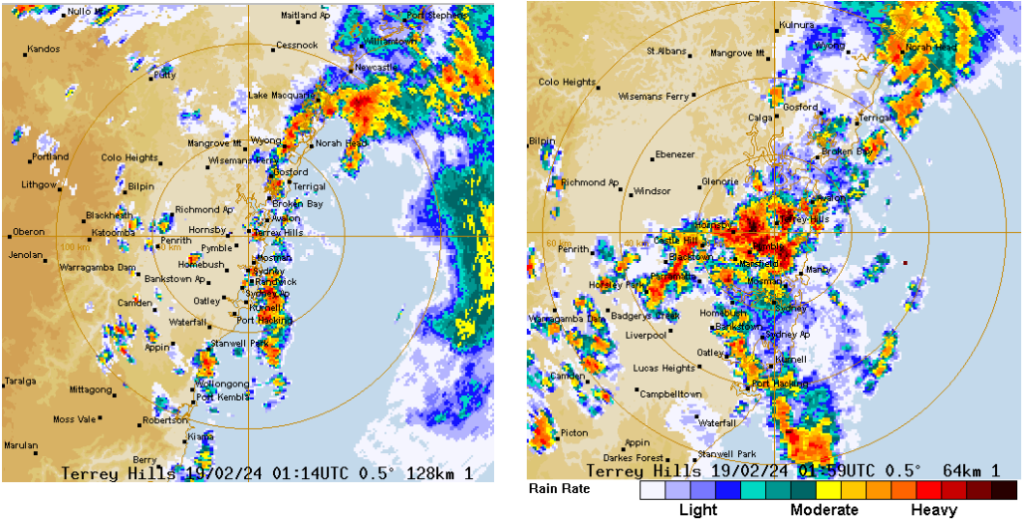The 19th of February Sydney Storms: The Hidden Danger in Plain View
- Briefing Note 497
On the 19th of February 2024 severe thunderstorms impacted the whole of Sydney, before moving north and affecting the north coast of NSW. The severe storm caused major disruptions to the city’s transport network and saw several calls for help to the NSW SES.
Monday’s intense thunderstorm event occurred within the warm humid easterly airflow that has been a consistent feature of Sydneys climate this summer. Most Sydney residents are familiar with the typical hot-summer-afternoon thunderstorm that forms in conjunction with a cool change. However this storm developed at around mid-day as part of a mesoscale convective system that intensified along the convergence of warm moist easterly airflow at the surface and cooler southwest airflow aloft. Strong cyclonic circulation developed over the Sydney area at about 12:00pm where enhanced convection produced intense thunderstorm activity and torrential rain. By 3pm the storm had mostly passed over Sydney, heading north.

Impact of the Severe Storm
During the severe storms Sydney recorded around 75,000 lightning strikes within 3 hrs. Four people were struck by lightning while seeking shelter under a tree at Sydney’s Botanic Gardens near the Sydney Opera House. They were taken to hospitals in serious and stable conditions with injuries from burns and presenting cardiac symptoms.
The lightning also resulted three houses catching fire from Baulkham Hills to Bronte and Sylvania, demonstrating how widespread the storm was. Several trees were also reported to have caught fire due to lightning. Meanwhile, more than 16,000 homes lost power in the cities north and northern beaches.
The storms caused major disruption to Sydney’s train network, damaging equipment at Milsons Point. This resulted in the T1 North Shore Line being shut down, and also caused delays to the T9, T2 and T3 lines.
Sydney Airport was also impacted by the storms, with lightning blasting a hole in the tarmac on the main runway, causing lengthy delays with some flights even cancelled.
The torrential rain caused flash flooding Sydney wide. At Kings Langley 48mm fell in one hour, approximately a 1 in 20 year rainfall event. The NSW SES carried out seven rescues from Miranda to Penrith. There were another 42 flood related incidents, the majority being cars trapped in floodwater, with several roads experiencing flash flooding. Overall, the NSW SES had 575 calls for help statewide.

Lightning in Australia
While the storm was intense, Australian localities have experienced the destructive effects of lightning before. PerilAUS, Risk Frontiers’ database of natural hazard impacts, was interrogated for previous instances of lightning impacts.
In terms of fatalities, records dating back to 1788 show that at least 1023 people have died due to lightning strikes. As were the four persons injured in the severe storms of 21 February 2024, a number of those who died had been doing their best to shelter from a more common element of storms – rain – by sheltering underneath trees or open-sided structures. In fact, this was the case for the very first such fatal event recorded in PerilAUS, in 1793: two convict “lads” took shelter below a tree from the rain during a storm. The tree was struck by lightning and the two died. It was reported, “There was no doubt that the shelter which they sought had proved their destruction, having been struck dead by lightning, one or two flashes of which had been observed to be very vivid and near.” [Collins, 1798].
There are a number of routes lightning can take when striking a person:
- direct – the lightning travels directly to the person – often fatal
- side flash – the lightning starts earthing itself through, e.g., a tree and then “jumps” the air gap from the tree to the person and finishes earthing itself through the person – often fatal
- contact voltage/ potential – where the person is touching the struck object – e.g., a person is leaning against a tree – and the lightning, again, starts earthing itself through the tree then finishes through the person – can be fatal
- step voltage – this is generally where the lightning strikes a tree or other object, or the ground or the sea, but then the voltage travels along the ground or sea disperses from that point. Depending on the distance from the initial strike, the ground (or sea) will be at different potentials. A person standing at some distance from a tree, which is struck, can be affected IF one of their feet is closer to the tree (or other struck object) than the other. This is not often fatal to humans, but often fatal to stock (cattle, sheep, horses) – most probably because the voltage travels through their entire body, including the heart, rather than just up one leg and down the other.
One interesting thing in relation to lightning deaths is that, looking at the past three decades of record, from 1994-2023, total average annual deaths have stayed relatively constant at one to two deaths per year (varying from zero to four per year). This is slightly lower than the average annual deaths for the decades prior to then found in previous studies by Risk Frontiers (Coates et al, 1993; Coates et al, 2017), which ranged from highs of seven to ten deaths per year over the decades from 1854-63 to 1934-43, to five per year for 1944-53, down to two to three per year for the decades of 1954-63 to 1984-93. However, the decadal total deaths for 1994-2003, 2004-2013 and 2014-2023, at 20, 13 and 19 respectively, show no particular downward trend.
As we saw in the most recent thunderstorm, as well as killing or injuring people (and livestock and pets), lightning can cause damage to the built (and natural) environment. Lightning strikes can take down trees and/ or power poles, which then pose their own dangers, including taking out power or communication networks, affecting up to tens of thousands of customers. Lightning strikes can cause electrical damage to houses and can start fires – in houses but also in inaccessible areas of bushland which, during high fire danger days, can be problematic. Lightning strikes to buildings can also cause more “physical” damage, such as ceiling collapse, veranda collapse, stone paving or concrete slabs being blown apart. Trains and trams can be affected; aircraft can be struck on the runway or in midflight.
The best place to be when a thunderstorm is about is inside an enclosed building or vehicle. There is often advice given, if caught outside during a storm, to move away from any trees or other tall objects and to crouch down, feet together, touching the ground with just the feet (this is to best minimise the likelihood of the different forms of lightning strike).
Far better is to:
- Avoid the situation altogether:
- take note of any storm forecasts (realising the inherent difficulty in the accurate forecasting of localised weather events) and plan accordingly and
- note, if you see a storm building, or hear thunder, that it is time to move inside
- If you are outside, rather than “assuming the position”, run as if your life depends on it (it may well do) to either
- a house – nowadays, most houses are well protected from lightning. But please, to avoid providing a conduit for lightning to enter:
- close doors or windows and
- don’t use your landline* (using mobile devices is fine)
- a car – cars act like a Faraday cage. The lightning is conducted around the outer metal casing and earthed through the tyres. The car may sustain some damage –the tyres may even explode – but the person inside will be totally safe, if somewhat startled.
- a house – nowadays, most houses are well protected from lightning. But please, to avoid providing a conduit for lightning to enter:
*Note that, thus far in Australia, although people have been badly injured from lightning whilst on a land phone line, no one has died – although this is not the case in other countries, just as the USA.
References
Coates L., Blong R. and Siciliano F., 1993, Lightning fatalities in Australia, 1824-1991. Natural Hazards, 8, 217-233. http://link.springer.com/article/10.1007%2FBF00690909
Coates, L., Haynes, K., Radford, D., D’Arcy, R, Smith, C., van den Honert, R. and Gissing, A., 2017, An analysis of human fatalities from cyclones, earthquakes and severe storms in Australia. Report for the Bushfire and Natural Hazards CRC. https://www.bnhcrc.com.au/publications/biblio/bnh-3568
Collins, David, 1798, An Account of the English Colony in New South Wales: with remarks on the dispositions, customs, manners, etc. of the native inhabitants of that country
About the author/s

Jacob Evans
Jacob has been involved in the development of our FloodAUS, CyclAUS and QuakeAUS Cat-Loss models. He specialises in data science and mathematics.
Jacob received his PhD in Condensed Matter Physics from Macquarie University. Jacob’s interests include data science, numerical modelling, physics and mathematics.
Joining Risk Frontiers in 2017, Jacob has worked across a range of projects from model development and climate risk management to resilience and portfolio modelling.
Notably, Jacob has employed techniques such as machine learning and statistical analysis to understand the vulnerability of risk across Risk Frontiers catastrophe suite, as well as applying machine learning algorithms for flood, cyclone and earthquake models. He also works on hazard and loss modelling.

Lucinda Coates
Lucinda is a Senior Research Consultant at Risk Frontiers. With over 30 years in the natural hazards field, she specialises in the impacts of and vulnerability vs resilience to hazard events. Highly experienced in data analysis, Lucinda also manages PerilAUS, an Australian database of hazard impacts.

Stuart Browning
Stuart is Risk Frontiers' Climate Risk Scientist, with extensive experience studying the weather and climate in Australian and the Asia-Pacific region. His focus is to understand the large-scale climatic drivers of extreme weather events to better quantify risk over seasonal to multi-decadal timescales, using reanalysis data, model simulations, and paleoclimate records.
